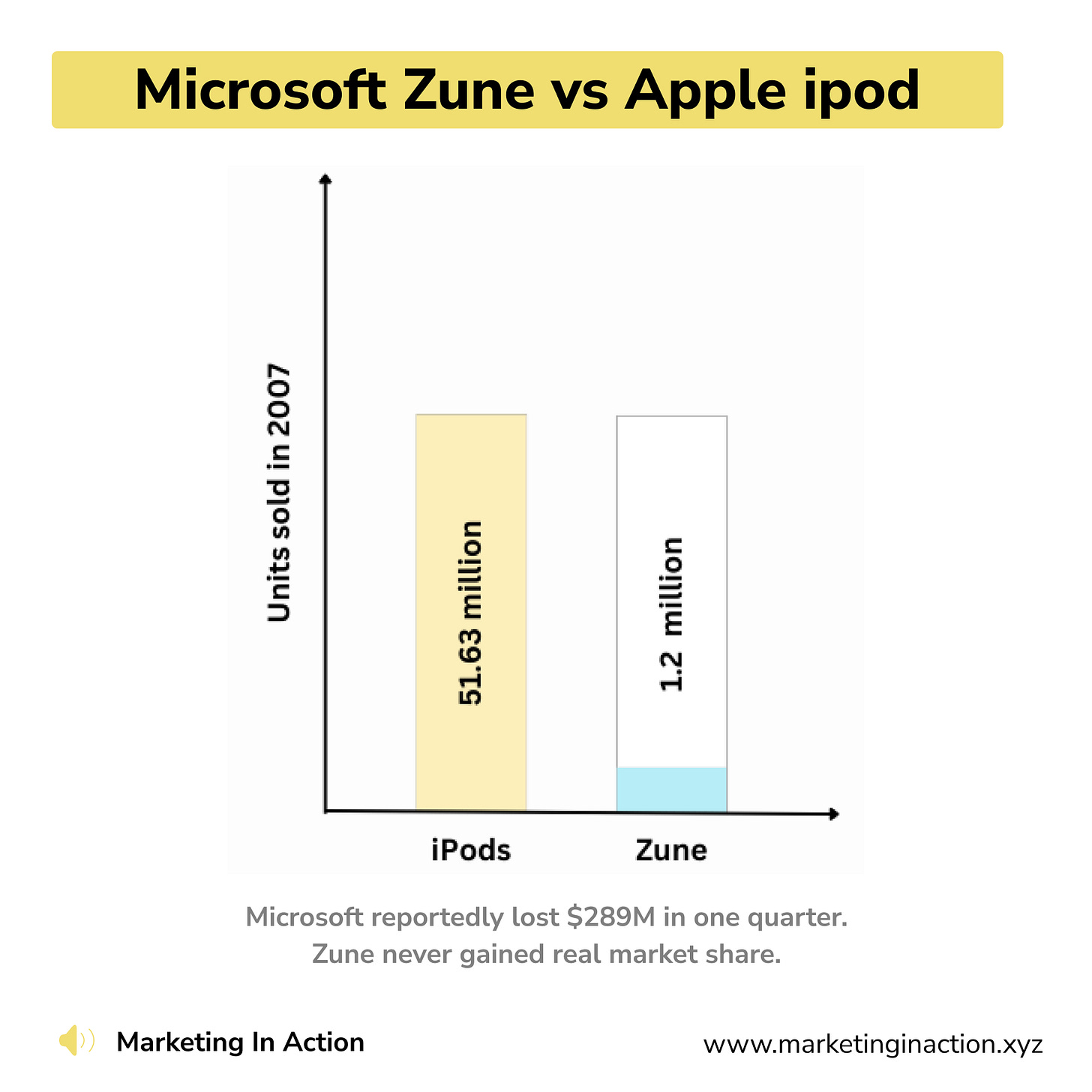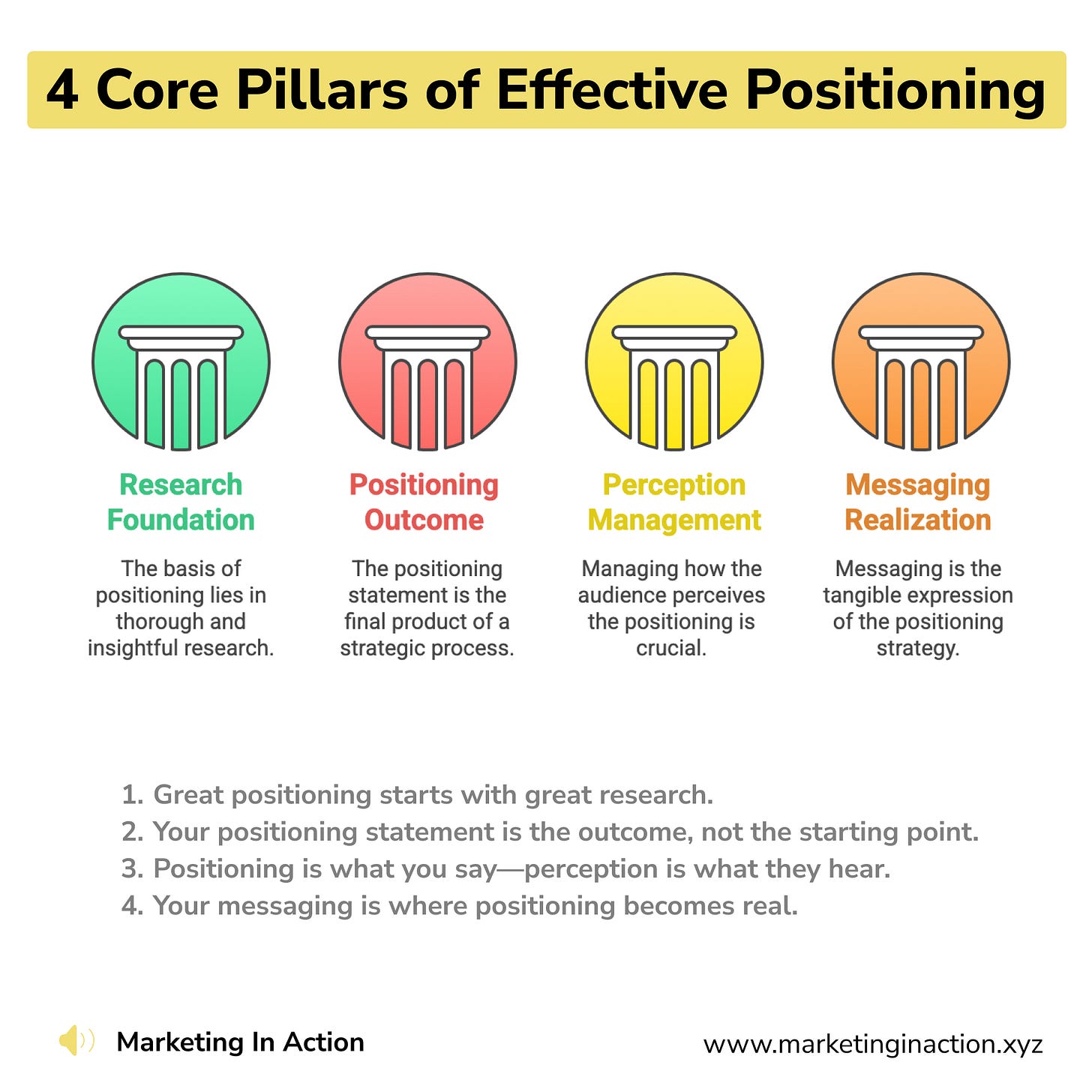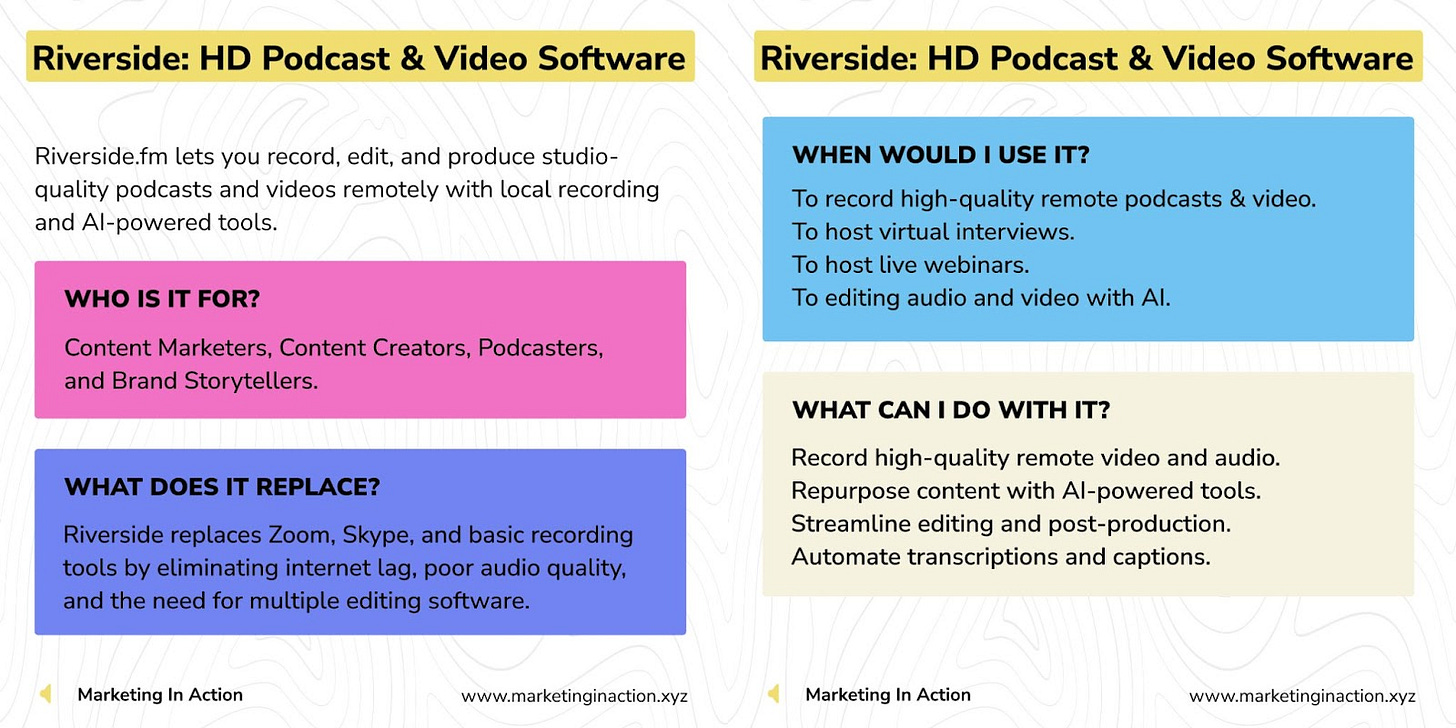MIA #10: Positioning & PMF Lessons from Microsoft’s $289M Zune Failure
A practical framework and template for positioning software products (so your customers actually care).
Thanks for reading MIA—everything you need to put marketing into action—templates, frameworks, community, data, insights, case studies, ideas, and martech/GTM tools. Share it with your network! ~James
This edition is brought to you by Clay – the GTM platform that helps you build AI-driven workflows without wasting SDR time on research. It is the ultimate tool for automated prospecting and enriched outreach data.
We did a deep dive into the Clay AI GTM platform here:
Every product has a story—but not every product knows how to tell it.
In this deep dive, we’ll break down product positioning and messaging in a two-part series:
Part 1 (you are here): How to position software products.
Why world-class engineering and big marketing budgets can’t compensate for unclear positioning
What product positioning really means (and why most teams get it wrong)
Why positioning is how you signal PMF to the right audience
A 4-part framework to define positioning that actually converts
Part 2: How to translate positioning into homepage and landing page messaging that converts.
Why messaging isn’t just what you say—but what customers hear
How to turn your positioning into high-converting homepage and landing page messaging
Real examples and templates you can apply right now
In 2006, Microsoft launched the Zune, a portable media player designed to compete with Apple’s wildly popular iPod. In 2009, Microsoft released an upgraded version—the Zune HD—but by 2011, just two years later, all Zune products were discontinued. Despite having the resources, distribution, and technical expertise, the Zune was a spectacular failure.
While Apple positioned the iPod as a lifestyle product – “1,000 songs in your pocket” – with sleek design and emotional resonance through its ads, Microsoft positioned Zune as just another technical alternative with similar features. There was no clear differentiation, no emotional hook, and no compelling reason for users to switch from a brand they already loved.
Robbie Bach, Former Microsoft executive had this to say about Zune’s positioning and messaging failures:
“On the Zune side, and this is as much my fault as anybody’s, I think our marketing message was very confused. I don’t think people walked away saying, this is what Zune is and this is why it’s different. This is why I have to have it. We did some really artsy ads that appealed to a very small segment of the music space, and we didn’t captivate the broad segment of music listeners. Not complicated.”
While Microsoft never publicly disclosed the exact amount spent on the Zune, it's estimated that the company lost hundreds of millions of dollars developing and marketing the product, with some reports suggesting a loss of $289 million in one quarter alone. Despite millions spent on marketing, the Zune never gained significant market share.
Consumers didn’t see how the Zune was meaningfully better or different than the iPod.
Microsoft failed to answer the basic positioning question: Why should anyone care about this product over what they’re already using?
What exactly is positioning?
According to April Dunford, “Positioning is defining how you are the best at something that a market cares a lot about”.
This definition comes from her book Obviously Awesome, published in 2019, where she outlines a practical, step-by-step approach to crafting positioning that resonates with the right customers and drives growth.
A typical Positioning Statement goes like this:
For [target buyers] who [statement of the need or opportunity], the [product name] is a [product category] that provides [main benefits]. Unlike [primary competitor] which provides [competitors’ benefits], our product [statement of primary differentiation].
This positioning statement is an adaptation from Geoffrey Moore's "Crossing the Chasm" book (first published in 1991).
👉🏽 Join the Marketing In Action WhatsApp Community where MIA Newsletter subscribers network, and gossip (what’s trending).
Why is positioning important?
As we’ve seen from the Zune example, even with great tech, marketing and distribution, bad positioning can sink a product. If your market doesn’t understand who it’s for, what it does better, and why it matters, they’ll ignore it—no matter how much you spend.
Positioning is also tightly linked to Product-Market Fit (PMF). Even if your product solves a real problem, unclear positioning can prevent the right users from seeing its value—making it feel like you haven’t reached PMF, when in fact, you just haven’t communicated it effectively.
Positioning shapes how your product is perceived in the minds of customers. PMF needs positioning—period.
Great positioning ensures your marketing resonates with the right audience, aligns internal teams, and creates a strong foundation for messaging, pricing, and go-to-market strategy.
Let’s apply the positioning statement to see how Microsoft could have positioned the Zune:
For young, socially connected music lovers who want to share and discover music on the go,
The Zune is a portable media player that provides wireless song sharing, music discovery, and social connectivity.
Unlike the iPod, which provides a closed, solo listening experience,
Zune enables a more social, discovery-driven way to enjoy music.
Why this works:
Clearly identifies a specific target audience – young, socially connected music lovers.
Addresses a distinct need – sharing and discovering music on the go.
Defines the product category – portable media player.
Highlights key benefits – wireless sharing, discovery, and social connectivity.
Establishes a contrast – differentiates Zune from the iPod’s solo, closed ecosystem.
Creates emotional resonance – emphasizes social connection and music discovery, not just features.
Answers “Why choose this?” – gives a clear, compelling reason to pick Zune over the iPod.
What actually happened:
Microsoft positioned Zune as a technical alternative to the iPod: “Like the iPod, but from Microsoft.”
No specific audience.
No emotional resonance or lifestyle appeal.
No clear reason to switch from the iPod.
Ads were abstract and confusing (as Robbie Bach admitted).
This vague, undifferentiated positioning left consumers asking: "Why should I care?"—and ultimately, most didn’t.
The 4 core pillars of effective positioning
Zune’s story makes the value of clear positioning obvious—but crafting strong positioning is rarely that simple. Behind every effective statement is deep research, cross-functional alignment, and a deliberate effort to connect with what your market truly cares about.
To do positioning well, there are four core pillars you need to understand and apply. These pillars go beyond filling out a template—they represent the deeper truths that make positioning effective, memorable, and actionable. Let’s break them down.
1 – Your positioning statement is the outcome, not the starting point
A positioning statement isn’t something you fill out in 30 minutes—like I did in Zune’s case—or during a team brainstorm. It’s the final artifact of a much broader, cross-functional process that involves deep collaboration between product, marketing, sales, customer success, and leadership. This process takes time—often weeks or months—and requires buy-in across the company.
Done well, a positioning exercise is more than just marketing—it’s a strategic reset that clarifies who you're for, what makes you different, and where you fit in the market. It forces difficult conversations, sharpens focus, and gives teams a shared language to describe the product. When you treat the positioning statement as the outcome of a company-wide effort, it becomes a powerful internal compass—not just a marketing line.
2 – Great positioning starts with great research
Many companies jump into crafting a positioning statement with assumptions and internal opinions rather than customer insight. This often leads to vague or misaligned positioning that fails to resonate. The best positioning is rooted in market, customer, and competitor research—understanding your ideal buyers, their pains, how they compare alternatives, and what they value most.
That means talking to customers, analyzing competitors, listening to sales calls, reading support tickets, and even studying what your target market complains about online. Research helps uncover not only what to say, but how to say it in a way that matches your customers’ mental models. Without this foundational layer, your positioning is guesswork—and guesswork rarely converts.
3 – Positioning is what you say—perception is what they hear
Defining your product positioning is only half the battle—getting your audience to perceive it the way you intended is where the real challenge lies. You can craft the most compelling, differentiated statement on paper, but if your messaging, visuals, and customer experience don’t reinforce it, the market will form its own interpretation—or worse, ignore you entirely. Great positioning is not just what you say, but what people remember and believe about your product.
This is why alignment between positioning and perception matters so much. If your product is positioned as “easy to use” but your onboarding experience is clunky, customers will question your credibility. If you claim to be for enterprise teams but your website speaks only to solo founders, there’s a disconnect. To win, you need to consistently shape perception across every customer interaction.
4 – Your messaging is where positioning becomes real
Positioning lives in theory until it’s brought to life through messaging and customer-facing assets. This is where the rubber meets the road—your website homepage, landing pages, social media, ad campaigns, and even social bios must clearly and consistently communicate your positioning. If your homepage confuses visitors or buries your value prop, it doesn’t matter how good your positioning statement is.
Great messaging makes your positioning tangible. It connects the dots between your unique value and what the customer cares about—fast. Every touchpoint should echo your core positioning ideas in language that speaks to your ICP (ideal customer profile). This includes the words you use, the visuals you choose, and the stories you tell. Done well, messaging turns positioning from a strategy doc into a growth engine.
📣 Share this with a founder or marketer on Twitter | LinkedIn | WhatsApp. It takes me 20 hours to write this. Sharing will only take 20 seconds.
Positioning framework & template
To build effective positioning, I’ve developed a practical framework and template that integrates elements from both April Dunford’s customer-centric methodology and Robbie Bach’s insights on strategic clarity and messaging.
This template is in the Premium MIA Resource & Template Library, available via annual subscription.
It breaks the process into four key layers: Customers, Product & Offering, Market Context, and Competitive Alternatives. Let’s walk through each one.
1 – Customers
Who are your ideal customers?
Describe the specific types of customers who care most about your product. What problems or pains are they actively trying to solve?
When do they use your product?
Identify the use cases or moments that trigger product usage. What are they trying to accomplish?
2 – Product & offering
What does your product do?
List the core capabilities and the key outcomes or benefits they deliver.
Why is it better or different?
Highlight your unique features or attributes that create value in a way competitors can’t match.
3 – Market/product category
What category are you in?
Define the market category or mental shelf customers place you on. Use language they recognize.
What trends make your product relevant now?
Mention any market shifts or industry changes that increase the urgency or appeal of your solution.
4 – Competitive alternatives
What would customers use if you didn’t exist?
List key alternatives: direct, secondary, and even indirect.
Where do those options fall short?
Identify the gaps, inefficiencies, or frustrations in the current solutions that your product addresses better.
This is the exact same framework that I’ve used to learn about and develop messaging for martech and go-to-market (GTM) tools. Here are some examples:
🧩 Get the full marketing template library.
Get access to 30+ Product & Growth Marketing templates, frameworks, and resources to execute marketing with clarity. Get access here.
20% off all MIA handbooks and templates when you use the code: MIA Community.
TL: DR
Get a PDF summary of this article here.
Positioning and messaging are more than just marketing exercises—they’re the foundation of how your product is perceived, understood, and ultimately adopted.
As we’ve seen from the Zune example, even world-class engineering and big marketing budgets can’t compensate for unclear or uninspiring positioning.
On the flip side, when you define who your product is for, what it does best, and why it matters—and communicate that consistently across your website and landing pages—you give your product the clarity and traction it needs to win.
Whether you're launching a new product or revisiting your strategy, use the frameworks and templates shared here to ground your positioning in real customer insight and bring it to life through compelling messaging.
Remember: your goal isn’t just to be understood—it’s to be remembered, valued, and chosen.
Was this helpful? Hit that ❤️ and let me know your thoughts in the comments! Want to see more of this content? Restack this post (if you're on Substack) and share it with your friends!
You might find these interesting:
Maja Voje GTM Strategist – How to build your GTM strategy from scratch.
April Dunford on Product Positioning – April Dunford’s guide to positioning and segmentation.
Product & Partner Recommendations:
Titaja – TITAJA is an on-demand subscription-based product marketing service (PMaaS) helping product-led, SaaS, and B2B companies unlock growth at every stage of the customer lifecycle, with GTM strategy, positioning, messaging, and demand generation.
James Praise – I partner with founders and marketing teams of product-led, SaaS & B2B startups to drive long-term growth from acquisition to retention to revenue.
Clay – Clay combines 50+ data providers, real-time scraping, AI, and outbound workflows, so you can send automated, 1-1 personalized campaigns (and book more meetings than your sales team).
Riverside – Riverside makes it easy to record remote podcasts and video interviews that look and sound like they were recorded in a million-dollar studio.
Testimonial – Testimonial makes it easy to collect text and video testimonials from your customers in minutes, with no need for a developer or website hosting.
If you want to collaborate or feature your product in this newsletter, check out our media kit, and shoot me an email.
MIA is trusted by 2,000+ marketers across Africa, the US, and Europe, helping you put marketing in action better, faster, and with context.
We’re building a village of marketers and founders who want to increase their odds of succeeding at marketing. You’re one of us. Share this newsletter with them.













